Owning a pet comes with a lot of responsibilities as well as problems. One of the biggest problems pet owners face is the various sicknesses their pets suffer from. Pets such as African Dwarf frogs are no exception to this either. One of the most common diseases these frogs suffer from is when they start turning red. But why is your African dwarf frog turning red?
The reason pet African Dwarf frogs turn red is due to a disease called the ‘Red-leg syndrome’. This disease not only affects African Dwarf frogs but also affects other amphibians, such as salamanders and toads. It is a bacterial disease, caused by the bacteria called Aeromonas hydrophila. Its symptoms include anemia, energy loss, etc.
Let’s take a deeper look at what red leg syndrome is and what should you do if your frog suffers from it.
The reason your African dwarf frog is turning red
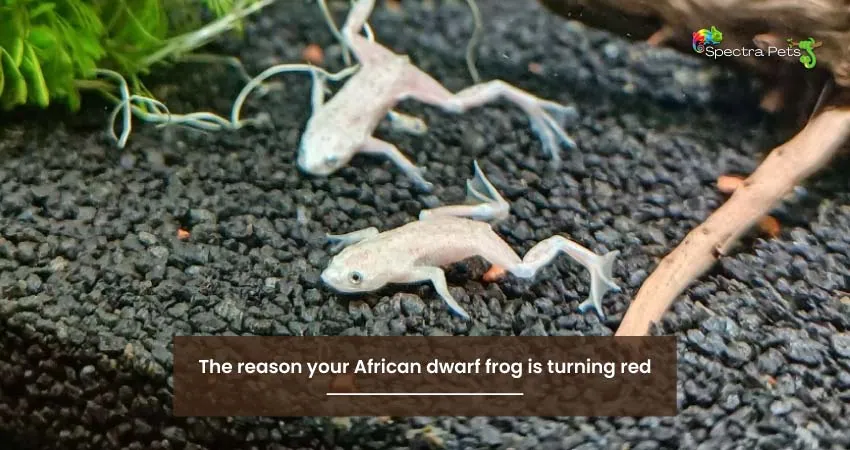
Keeping your pet healthy is one of your biggest responsibilities as a pet owner. Apart from it being a responsibility, if you truly care for your pet, you should be ready in case your pet contracts any disease. As African dwarf frogs are not native to the UK, you should take extra care when it comes to their health.
So when your frog starts to turn red, it’s only natural that alarm bells will start ringing in your head. To prevent your frog from dying due to this, you must know what is causing this and take the necessary steps to save your frog.
If you see your African Dwarf frog turning red, it is because it has been suffering from the red leg disease, which is common among all amphibians. Frogs, toads, and salamanders all suffer from this disease. This disease is caused by a bacteria called Aeromonas hydrophila.
But this is not the only reason your frog might turn red. Some fungi and viruses can also be the cause of the reddening of your frog. Before you treat your frog for the disease, you must know the cause of your frog turning red and treat them accordingly.
Causes of African Dwarf frogs turning red
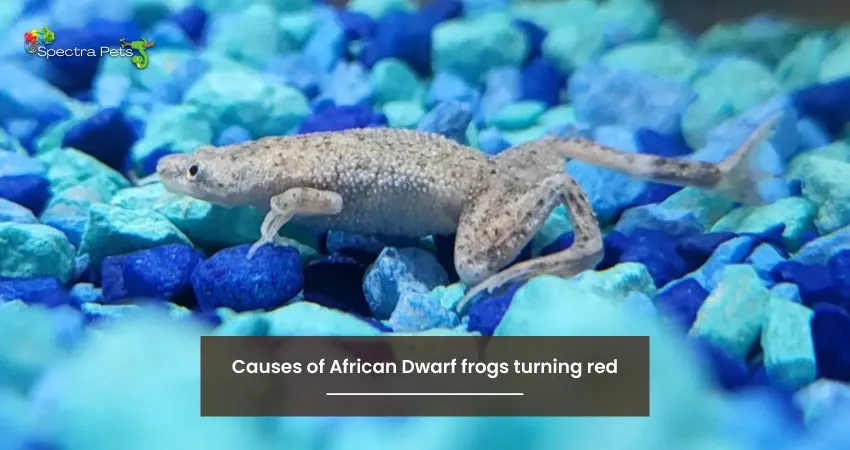
Now you know that the red-leg disease causes your dwarf to turn red, along with some viruses and fungi. But what causes them to attack your frog in the first place? Certainly, they aren’t originated out of nowhere. Here are a few reasons why your frog might be suffering from this disease:
- Underfeeding your frog
- The water conditions of newly bought frogs are poor
- Environmental conditions are not up to the mark.
Symptoms of red leg disease
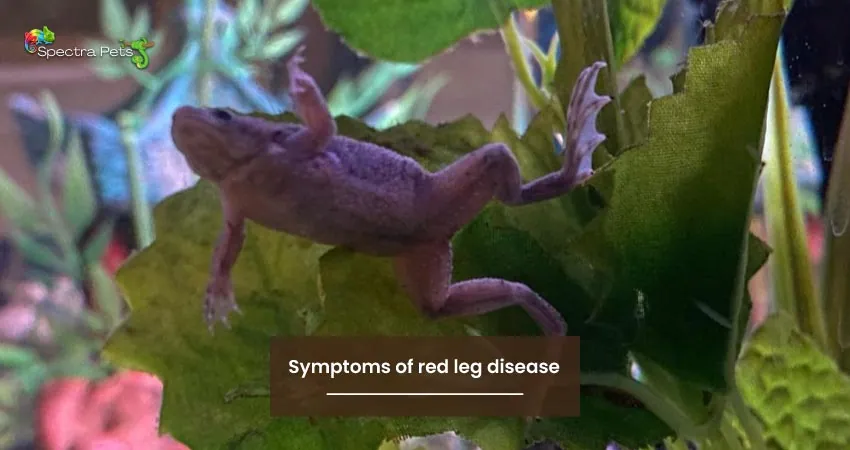
The most common symptoms of red leg disease are lethargy, weight loss, bleeding, and of course, red leg. Let’s take a look at them:
1. Lethargy
An African dwarf frog affected by the red-leg disease will become increasingly inactive as the disease progresses. They will stop moving around a lot, instead opting to stay in one place for an extended period. When the disease has spread fully, the frog will become completely inactive.
2. Anemia
When an African dwarf frog is affected by the red leg disease, it might cause it to have sores which in turn., can cause bleeding. As a result, the animal will suffer from blood loss. Check your frog for any sores or bleeding from its skin. Bleeding will only occur if the disease has reached a dangerous point. As soon as you see something like that, contact a veterinarian immediately.
3. Weight loss
If your frog has red leg disease, it will stop eating. At first, they will reduce the amount of food they take, and eventually, they will stop eating entirely. As a result, the frog will continue to lose weight, to the point it will become visible. Take action if you see your frog isn’t eating.
4. Red legs
The most obvious sign that your African Dwarf frog is suffering from red leg disease is you will see their legs are becoming red. If you see the inside of your frog’s legs getting increasingly redder, it is probably because of the red leg disease. As soon as you notice your frog’s legs getting red, take it to a vet for a proper diagnosis.
What to do when your frog has red leg disease
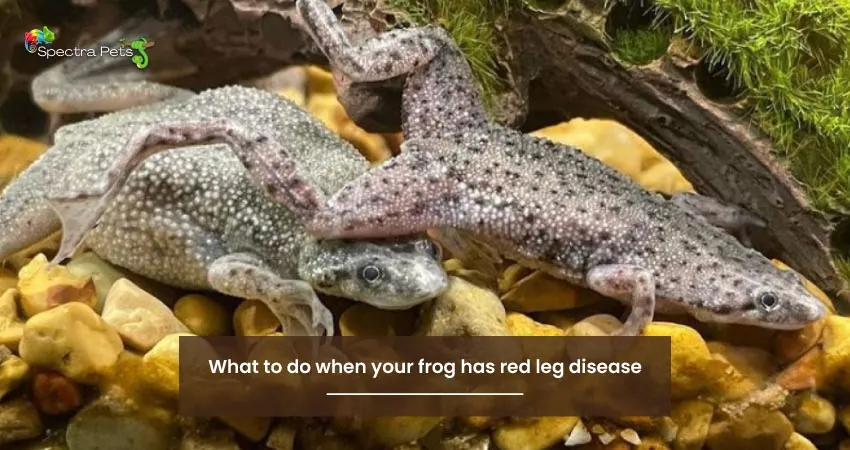
Just because your frog has contracted the red leg disease, doesn’t mean that’s the end of it. You can take a few steps to ensure your frog survives after it has this disease. Let’s take a look at what you should do to save your pet:
1. Take it to a vet
As soon as you think that your frog is sick from red leg disease, take it to a nearby vet. They will be able to tell you the reason your frog is turning red and prescribe medication. If the disease is indeed the red leg disease, they will treat it accordingly, the same will be the case if it is caused by a virus or fungus.
2. Quarantine the frog
If you have multiple frogs in a tank and only one has contracted the red leg disease, make sure to keep the diseased frog apart from the other frogs. This will ensure the other frogs will not be affected by the disease as well. After putting the frog in another tank, ensure the items in the tank are thoroughly cleaned to prevent further infection.
3. Medicate the frog
Once you take your frog to a vet, they will diagnose the cause of the disease and prescribe you the appropriate medication. Ensure you are administering the medication properly and on time. This will expedite the process of your frog betting better. Don’t stray from the instructions your vet has provided you when medicating the frog is concerned.
4. Keep it under constant surveillance
As you keep administering medication to your frog, make sure you are noticing every detail of its activity. The frog will not heal overnight, and it is a gradual process. Keep monitoring its activities and note how it is behaving to see if the medication is working. Also, keep the tank and its environment clean and hygienic.
How to prevent Red leg disease
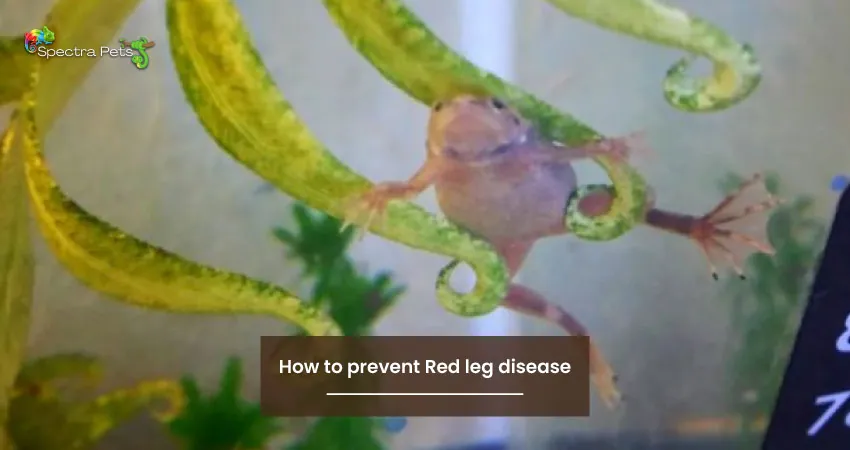
As we all know, prevention is better than cure. If your African Dwarf frog doesn’t get sick in the first place, then you won’t have to worry about taking it to the vet and saving its life. Here are a few ways you can prevent red leg disease:
1. Feeding them properly
One of the best ways to keep red leg disease at bay is to feed your frog properly. Apart from feeding it regularly, you also have to feed it a balanced diet, so that the frog doesn’t suffer from malnutrition. While feeding crickets, dusting the insects with calcium powder is a good idea. You can also feed them nightcrawlers and mice as they are a rich source of nutrition. But make sure you only feed mice to your frog as an occasional treat.
2. Keeping the tank clean
A clean tank will keep almost every kind of disease and germ away, no matter what animal you keep in it. African Dwarf frogs are no exception to this. Keep the water in the tank clean and free of chlorine. Also, you have to change the tank water every day. When you feed the frog, never overfeed it as the leftover food will make the tank water nasty and toxic.
If you see some food being left over by the frog, clean it up as soon as possible. Along with that, clean the entirety of the tank regularly.
3. Provide the frog with a proper environment
The environment inside the tank plays a big role in the well-being of an African dwarf frog. You should ensure the environment is beneficial to your frog, not what you think looks great. For starters when you choose the lighting in the tank, choose UV lighting so that your frog can synthesize calcium and have a better skeletal structure.
When it comes to the humidity levels of the tank, set the levels according to the specifications of the animal. Maintain the temperature between 20 to 26 degrees celsius so that the frog doesn’t overheat or go into hibernation due to lower temperatures.
Finally, although they can live well with other frogs of the same species, doesn’t mean they will enjoy being overcrowded. If you want to keep multiple frogs in a tank, then ensure adequate space is available for each of them to prevent the frog from being stressed out.
Final Words
One of the scariest things you can face when having an African dwarf frog is when your frog starts turning red. The best way to deal with this is to know why your frog is turning red. Once you know the reasons, you can deal with them accordingly.
